Sun GlassFish Mobility Platform Deployment Scenarios
The Sun GlassFish Mobility Platform software can be deployed in three different scenarios:
Service Provider Managed Deployment Scenario
In a service provider managed deployment scenario, such as the one shown in Figure 1–1, the Gateway engine and its associated sync database form the Gateway tier in the service provider's network. The corporate network includes the Sun GlassFish Mobility Platform Enterprise tier components and the EIS/EAI system.
Figure 1–1 Service Provider Managed Deployment

Service Provider Hosted Deployment Scenario
In a service provider hosted deployment scenario, all of the Sun GlassFish Mobility Platform components and the database or EIS/EAI system are in the service provider's network.
Enterprise Deployment Scenario
In an enterprise deployment scenario, such as the one shown in Figure 1–2, all of the Sun GlassFish Mobility Platform components and the database or EIS/EAI system are in the corporate network.
Figure 1–2 Enterprise Deployment Scenario

The service provider's network includes no Sun GlassFish Mobility Platform components. The corporate network, in essence, controls all of the Sun GlassFish Mobility Platform components as well as the database or EIS/EAI system. In the corporate network, the Sun GlassFish Mobility Platform components can be configured in a single-tier or two-tier configuration. These configurations are described in Sun GlassFish Mobility Platform Architecture.
- © 2010, Oracle Corporation and/or its affiliates
